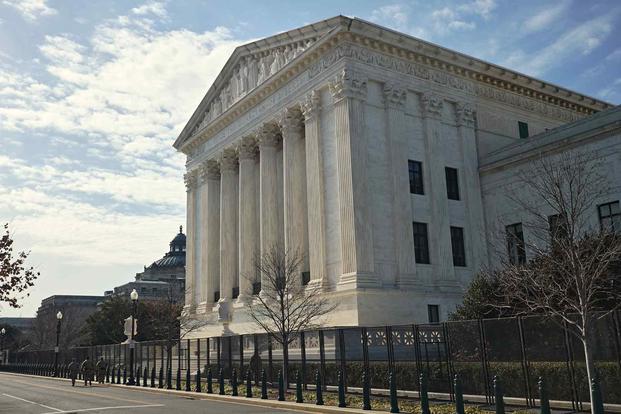Several justices on the U.S. Supreme Court on Monday questioned the financial implications of ruling in favor of plaintiffs in a case that would expand retroactive disability payments to retired service members who receive combat-related disability compensation from the Defense Department.
While listening to arguments, both liberal and conservative justices peppered retired Marine Cpl. Simon Soto’s attorney on whether an interpretation of the law would affect time limits of other military compensation programs or result in millions of dollars owed to other claimants.
The case, Soto v. United States, represents an estimated 9,000 medically retired service members who say the Defense Department misinterpreted the law and prevented them from receiving the maximum amount of retroactive disability compensation for combat-related injuries.
Read Next: Army National Guard Clearing Yearslong Backlog of Enlistment Bonus Payouts
The government argues the Navy rightfully limited Soto’s retroactive pay to six years, citing what is known as the Barring Act, which limits disability claims to within six years of a veteran receiving a disability compensation rating from the VA.
Soto’s attorneys say the Barring Act does not apply to military claims decided and conferred by the service secretaries or the secretary of defense.
“[The law] says veterans apply — that is, submit a claim — and their application is to be considered by the secretary of the military department or the secretary concerned. That’s fairly explicit,” said Soto’s attorney, Tacy Flint.
Chief Justice John Roberts said any time a plaintiff claims they are an exception to the rule — “maybe injustice or something else” — it is a “significant opening of the barn door” that could result in government debt.
“If our ruling [is] that this is enough to get past the [law] based on this statute, the idea is that it would sort of open the barn door, getting around a statute that is critically important to protecting the public fisk,” said Roberts, referring to the amount of money the government has available to spend.
Justice Samuel Alito also questioned Flint’s rationale for making an exception for combat-related special compensation, or CRSC, decisions.
“What might have motivated Congress to think — generally, we want to have a statute of limitations for submission of claims to the government or for many other things — in this particular situation, we don’t want that?” Alito asked.
The Justice Department, represented by Caroline Flynn, assistant to the solicitor general, said Congress intended for the six-month time limit to apply and added that as many as six other military compensation programs would be affected by a ruling in Soto’s favor.
“We’re aware of no other military pay or compensation statute that opens up the department in that way,” Flynn said.
“And those six statutes, do they deal with big programs? Small programs? I mean, what’s the extent of the liability that the government is concerned with here?” asked Justice Sonia Sotomayor.
Flynn responded that the death gratuity benefit could be affected, the Basic Needs Allowance, disability severance and others, resulting in an indeterminate amount of payouts.
“We’re not saying that absolutely you have to have a timing rule, but we’re just saying they do tend to run together because … you are setting up a claim settlement process,” Flynn said.
Soto enlisted in the Marine Corps in 2000 and served two tours in Iraq in mortuary affairs. He developed post-traumatic stress disorder as a result of his job and medically retired in 2006.
In 2009, the Department of Veterans Affairs awarded Soto disability compensation for his service-connected mental health condition, and in 2016, he applied for combat-related special compensation — pay awarded to some service members who retire as a result of a service-connected medical condition.
When the Navy awarded Soto CRSC, it backdated the pay to July 2010 based on the interpretation of the law.
Soto’s attorneys have filed a request that he receive back pay up to $10,000. The suit would limit all plaintiffs to that amount if they were eligible for the maximum retroactive pay.
An opinion is expected in the coming months.
Related: Supreme Court Upholds VA Court Decision Not to Review ‘Benefit-of-the-Doubt’ Evidence in Veterans’ Claims
Story Continues
Read the full article here

